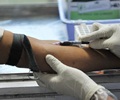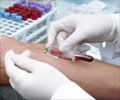Viral kinetics on therapy may be able to predict the likelihood of treatment success of 48 week peg-interferon (PEG-IFN) plus ribavirin (RBV) therapy for chronic hepatitis C.
Viral kinetics on therapy may be able to predict the likelihood of treatment success of 48 week peg-interferon (PEG-IFN) plus ribavirin (RBV) therapy for chronic hepatitis C.
In particular, recent studies have shown that sustained virological response (SVR) can be predicted by a rapid virological response (RVR), and an early virological response (EVR). Nevertheless, the current dosing regimens could potentially under-treat some patients and additional measurements of viral response is needed to facilitate individualization of therapy. Among predictive factors already reported, many are not readily available from daily clinical assessment, because they require genomic analyses and/or advanced experimental methods. The prediction with simply available data may be useful.A Clinical research article to be published on January 7 , 2010 in the World Journal of Gastroenterology suggested a novel but easily available on-treatment formula, which predicted SVR of patients who received PEG-IFN/RBV for 48 wk better than viral kinetics. The analysis was performed using the data of 176 patients with chronic hepatitis and hepatitis C virus genotype 1 who received 48 wk standard therapy. The formula was constructed using data from the first 100 patients enrolled and validated using data from the remaining 76 patients.The predictive potential was very high, as judged by area under the curve of receiver operating characteristic (AUC) analysis, which was more than 0.8 from week 4. In particular, the validity at week 24 was more than 0.85 of AUC. The positive predictive value (PPV) of the formulae were better at weeks 12 and 24 than the prediction with viral kinetics, and the negative predictive value (NPV) of the formulae were better at weeks 4 and 12. Evaluation of the formulae using data from the test patients revealed a very high AUC value of more than 0.85. These results suggest that formulae based on simple clinical data are superior to prediction by viral kinetics.The formula can be made with a personal computer using statistical software to create a logistic regression model. The formula was made for every cohort of patients affiliated to a hospital, and the prediction made is suitable for every cohort. The concept that extension of treatment duration can reduce relapse rates should be adopted only for a limited proportion of type 1-infected patients. The formulae we suggest might be helpful for patients who are expected to achieve SVR but do not do so. For those individuals, the method based on logistic regression analysis will show a clear direction of therapy in each case and enable the best tailored treatment. Further prospective studies should be performed to determine whether this approach really increases the SVR rate by selection of patients and extension of treatment duration up to week 72.
Source-Eurekalert
RAS















